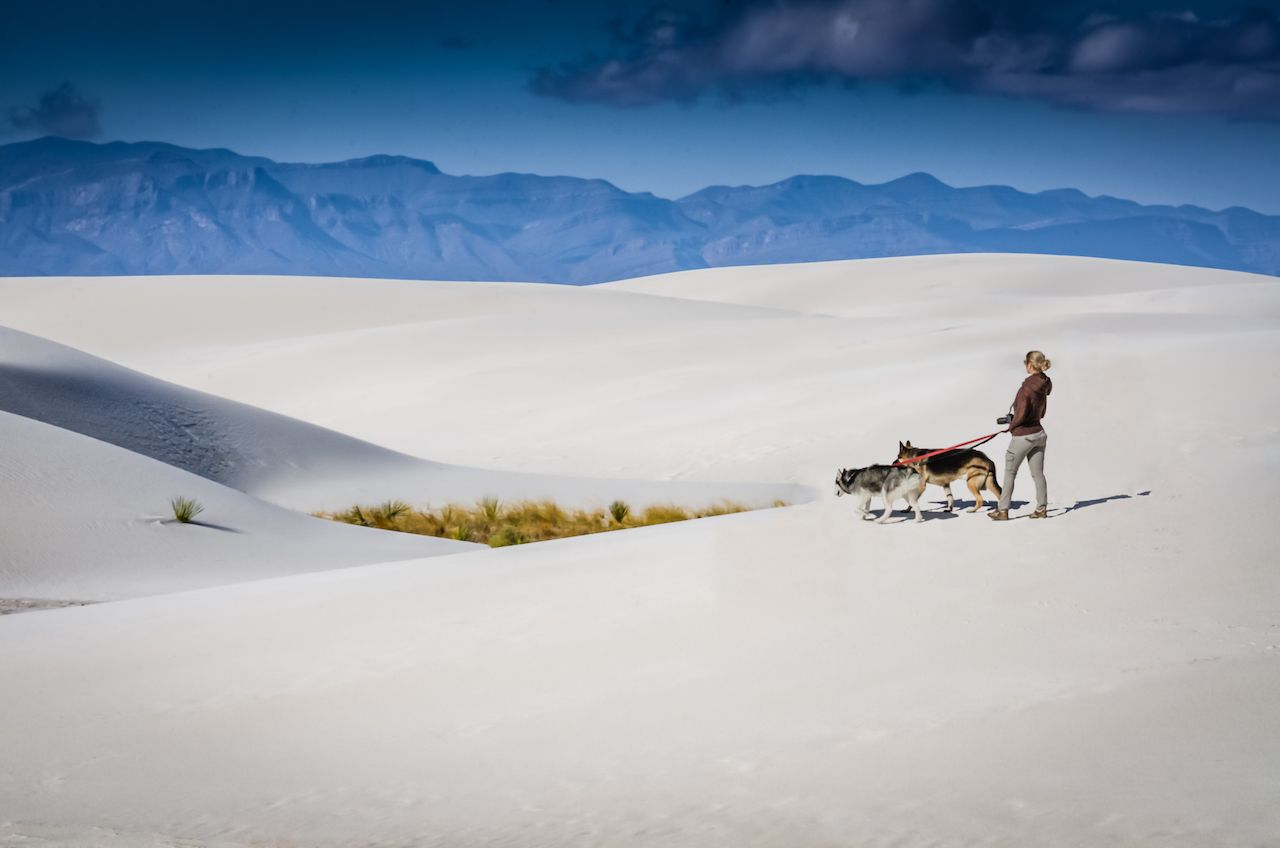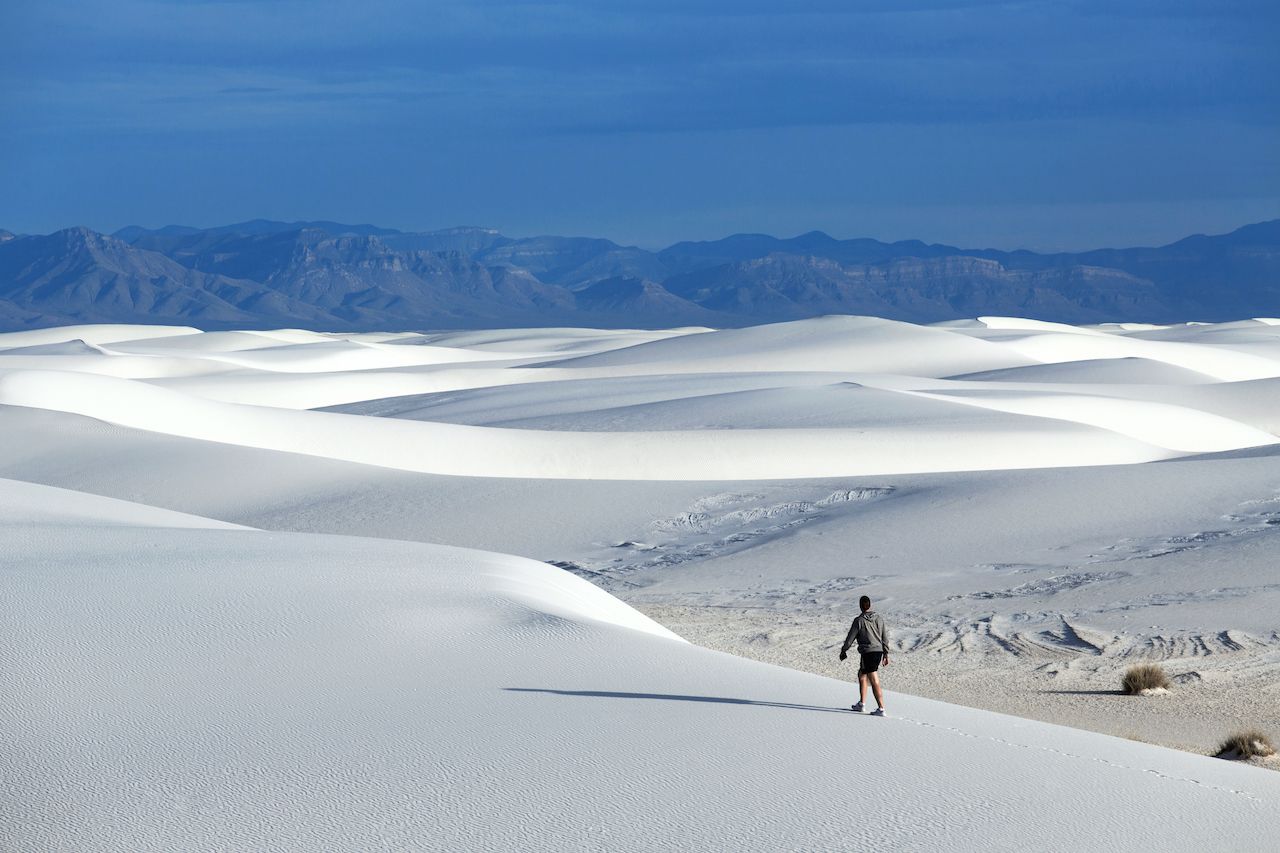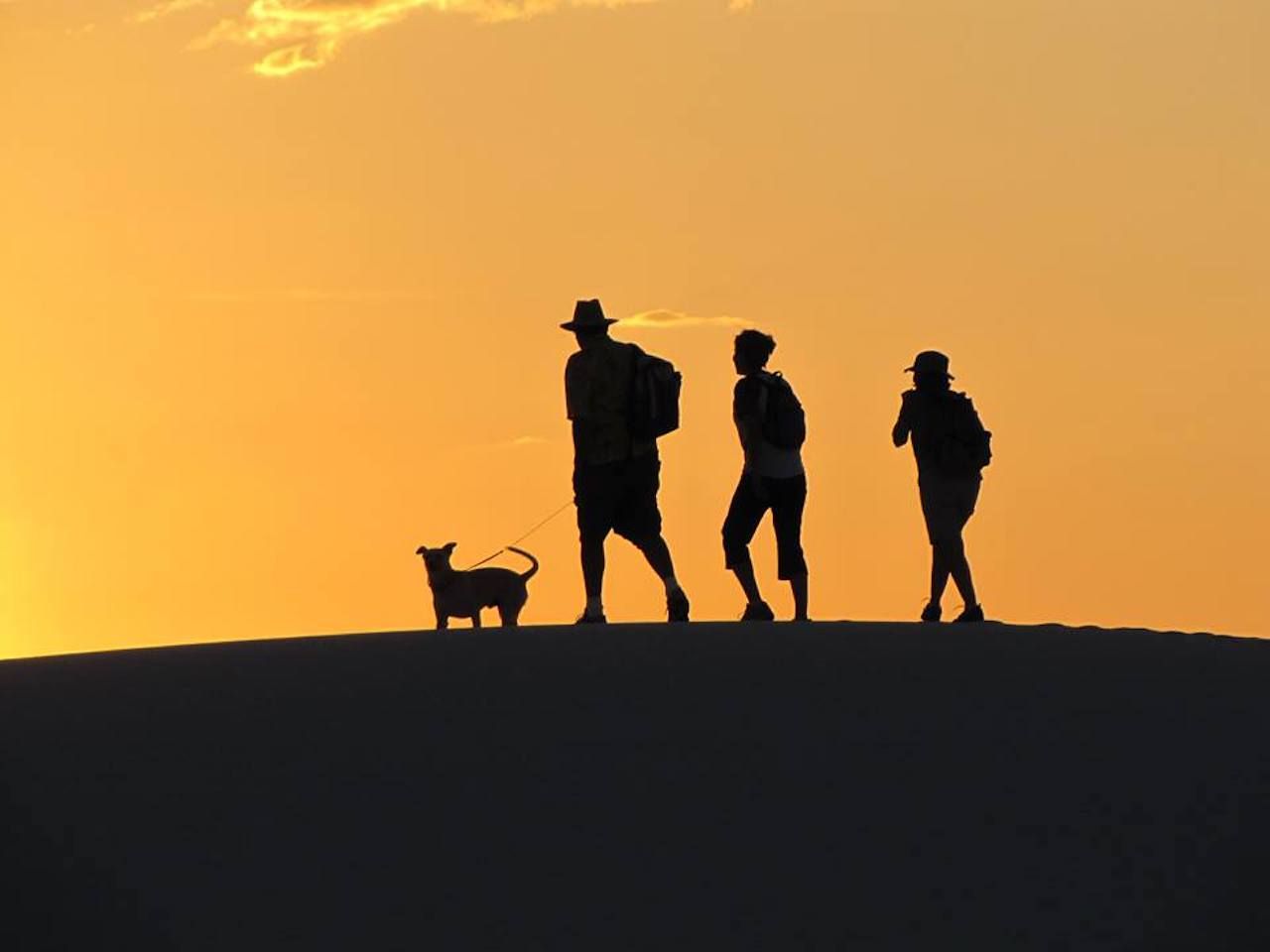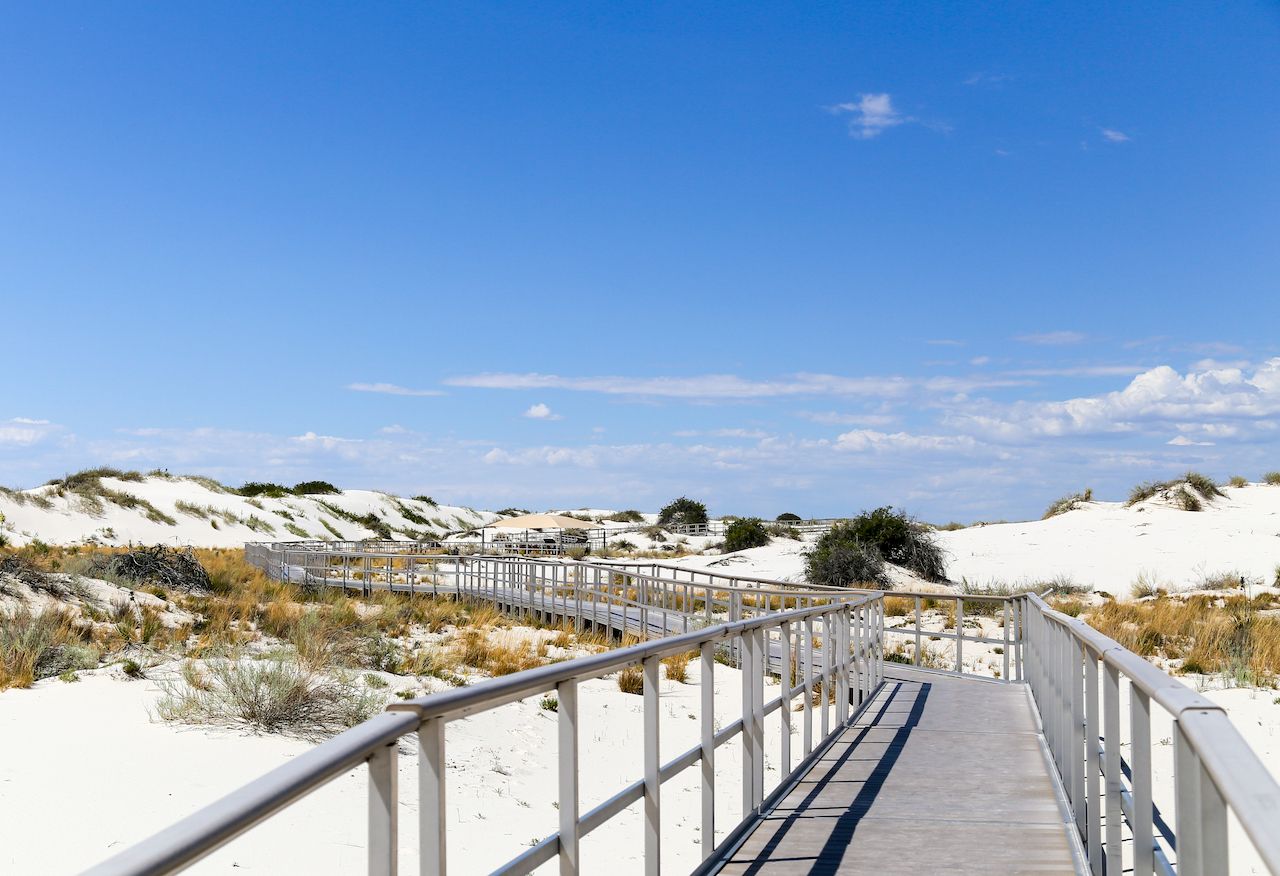Stepping out of your vehicle onto fine gypsum crystals is the closest thing to walking on the moon that most of us will ever experience. At White Sands National Monument, dunes of white sand ripple across a vast expanse of open desert, ceasing only at the feet of the towering Sierra Blanca mountains. This 224-square-mile protected area of rolling gypsum dunes in southern New Mexico is the truest embodiment of the state’s catchphrase as the “Land of Enchantment.” But any dog owner knows that putting national parks on their bucket list is no easy task, as most parks prohibit dogs from the most famous sites and campgrounds. Thankfully, White Sands National Monument will welcome your dog with open arms, making it the perfect place to road trip this summer. Here’s what you need to know to plan a trip here with your dog.


White Sands National Park Is the Best Natural Place in the US to Take Your Dog
They actively want your dog here.

Photo: Sandra Foyt/Shutterstock
It’s true. While many national monuments and parks will, at best, tolerate your dog if they have to and, at worst, ban them altogether, White Sands has devoted an entire page of its website to wooing four-legged companions — complete with a super corny photo that just might be Billy the Kid walking off into the sunset with a Boston Terrier. Leashed dogs are allowed on the hiking trails, and the park has even installed pick-up stations in case you don’t have an empty bag of chips on hand to clean up after your pet.
A few things to note about bringing your dog into the monument:
- It can get quite hot here, frequently pushing the needle into the 80s and 90s, if not hotter. As such, it is both ill-advised and illegal to leave a dog unattended in your vehicle.
- Make sure to give them plenty of water. Again, heat is a thing here, and you don’t want to have to cut a hike short because you didn’t bring enough water to share with the pup.
- Don’t be a jerk. This applies to both the dog and the owner. No one wants to have a peaceful hike interrupted by someone else’s dog sneaking up behind them and nipping at their heels, nor do they want to be kept awake at night by barking. Keep your dog leashed at all times and monitor their behavior at the campsite.
Standing barefoot on gypsum feels amazing.

Photo: sunsinger/Shutterstock
The “sands” in the name are actually the gypsum you’re stepping on, superfine crystals of the stuff that will flow through your fingers almost like water. The monument is located in the Chihuahuan Desert while the gypsum is the area’s most visible remnant of the former Permian Sea, which millions of years ago covered much of what is now the southwestern United States. The entire monument looks like a scene from a Star Wars film — so much so that it wouldn’t be surprising if an AT-AT Walker approached from the horizon. The soft crystals will also be easy on your pup’s paws as the sand stays pretty cool. Absolutely do not lose track of where you are within the monument. The rangers here can easily recall stories of hikers who lost their place and disappeared into the emptiness.
Where to hike inside the monument

Photo: Alberto Loyo/Shutterstock
The monument has five well-maintained hiking trails. The Alkali Flat Trail is for the true hiker: five miles of trail moving past Lake Otero. It climbs across dunes and really exposes you to the elements, making for more of a workout than a typical five-mile hike through the woods. The dogs will have plenty of space to wear themselves out as they trounce through the sand. For a slightly easier trek, hit the one-mile Dune Life Nature Trail and take some photos of the badgers, reptiles, and desert succulents that call the area home. The Interdune Boardwalk Trail is accessible to wheelchairs.

Photo: White Sands National Monument/Facebook
The one hike you absolutely must do is the sunset guided hike, where a ranger will lead you across the dunes to witness a sunset that rivals the sunrise experience at Maui’s Haleakala National Park or Bali’s Mount Batur. Inquire about this hike at the visitor’s center as soon as you arrive.
Beyond the established hikes, the monument has several parking areas where your crew can get the dogs out onto the sand to stretch while you play your finest game of hand hour-glass with the gypsum — an activity that is even more addicting than it sounds. These parking areas are strategically placed near some of the monument’s most beautiful dunes and photo opportunities.
How to snap the perfect photo of the dunes
View this post on InstagramA post shared by Robert Dingle (@rob_ding) on
To correctly photograph White Sands National Monument, you need to do four things straight off:
- Kneel down and take a close-up, side-angle shot of the sand rippling into the horizon, as seen above.
- Stand back up and shoot the same shot again, capturing the peaks of the Sierra Blancas in the background to show the true contrast of the area.
- Turn around and take another shot facing the other direction, and try to get as much barren desert into the shot as you can. Your friends back home likely won’t believe you took them all in the same place when comparing them side-by-side.
- Enlist one of your travel partners to run about 50 feet ahead and coordinate a pose with them for one of those corny-but-kind-of-cool forced perspective shots you’ve seen on Instagram. If you can somehow work your dog into that shot, that’s absolute perfection.
Getting to (and staying in) White Sands National Monument

Photo: Michael Rosebrock/Shutterstock
Despite its New Mexico address, White Sands National Monument is actually closer to El Paso, Texas, (1.5 hours) than it is to Albuquerque (3.5 hours). Coming from the Texas side, the fastest route is to head north on I-10 out of El Paso and swing a sharp right onto US-70 on the north end of Las Cruces and continue until you see the entrance signs. For those coming south on I-25, exit onto US-380 in the tiny town of San Antonio instead of proceeding south to Las Cruces, and you’ll save yourself about 20 minutes of backtracking north.
Backcountry camping is available inside the monument and accessed via the aptly titled Backcountry Camping Trail. The 10 sites are available on a first-come basis, but you must pick up a camping permit from the visitor’s center before you hit the trail. Keep in mind that national monuments are not national forest, meaning dispersed camping and popping a tent anywhere at your convenience isn’t going to fly. If you plan to camp, show up in the morning to get your permit, do your hiking and exploring to tire out both yourself and your dog, and then settle in at the campsite for the evening.
If camping isn’t your thing, head an hour north to the town of Ruidoso to stay over. Alamogordo is adjacent to the park, but there’s not much there beyond a few chain motels and a collection of tired restaurants. Ruidoso, on the other hand, takes the natural contrasts of southern New Mexico even further by throwing a quaint, affordable, and super dog-friendly mountain town into the mix of desert and gypsum sands that you’ve already trekked through.